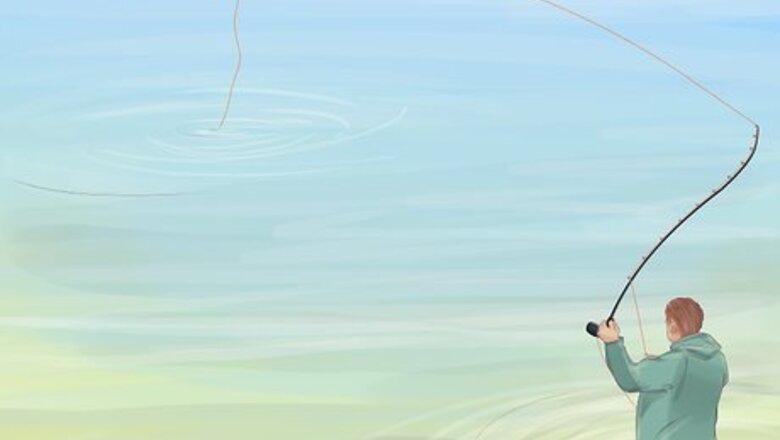
views
Casting and Reeling In a Fish

Use a two-stroke cast if you've got the room. If you're on a clear bank with no low-hanging trees, you should be able to use a two-stroke cast. This is a basic casting method, but it requires some clearance above and behind you. Make sure you have enough room before attempting this cast, as a low tree branch can easily snag your line and cost you your fly. Lead out approximately three rod-lengths' worth of fishing line. Hold the rod with your dominant hand. Check the line for tangles. If there are any tangles present, you'll need to straighten them out before casting. With your arm slightly extended, whip the tip of the rod up and back in a steady movement. Don't whip the rod too far back; you'll want to stop when the tip of the rod is pointing up and just slightly behind you. Watch as the line unfurls. The three rod-lengths' worth of line should be extended. Immediately before the line completely straightens out above/behind you, flick the rod forward to send the line out onto the surface of the water.
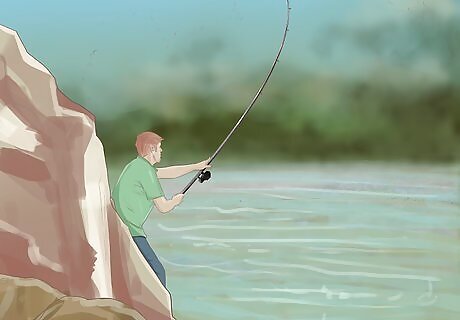
Try a roll cast if there's no room behind you. If there's not enough room above or behind you, you may want to try a roll cast. This is somewhat similar in action to the two-stroke cast, but it doesn't require as much room or as much loose line. Hold the rod in your dominant hand slightly in front of you. Check the line for tangles. Straighten out any tangles present before you attempt to cast. Gently bring the rod back. The tip should be above your casting shoulder, and a small piece of line should be hanging behind you. Move the rod forward. Start slow, then speed it up as your arm comes down. Don't whip the rod too far ahead. Stop when the tip of the rod is still angled slightly upward. The loop of line should unfurl and cast onto the surface of the water.
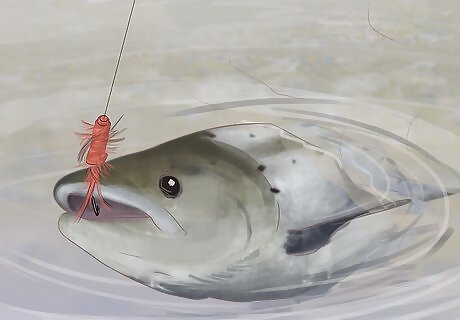
Make your fly attractive along the water's surface. Fish should see your fly as a real insect/invertebrate. How you manage the line will determine how convincing your fly is to a fish. There are two primary ways to imitate an actual insect: letting it drift without any movement on your part, or giving the line very slight, gentle twitches to imitate natural movement. Move your rod to the right or left to change the angle at which the line lays on the water. If you are upstream from a fish, keep the rod (and your rod arm) angled upstream. As the fly moves downstream with the current, slowly angle your rod and arm to face downstream at the same speed the fly is moving at to create a drag-free line. If a fish is feeding near the surface, try to cast your fly so that it lands near the fish's head and floats towards it.
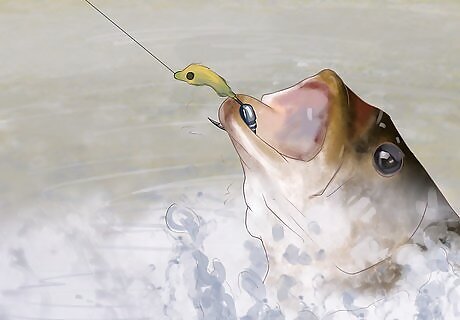
Hook a fish. Once you've gotten a bite (which you should be able to feel if the line is taut), you'll need to hook the fish. If you don't hook the fish, or if you don't hook it properly, it can easily get away off your line. Keep the rod's tip low to the water. That way when a fish strikes, you can move the rod's tip in the direction of line curvature. Keep the line as taut as possible. If you try to set the hook while there's excess slack in the line it will not move the hook whatsoever. Set the hook securely in the fish's mouth. You'll do this by continuing to hold the rod with one hand and pulling down sharply on the line with the other hand. Do not yank the rod tip upwards. Some fishers do this thinking it helps set the hook, but really it just complicates the process of reeling in your fish. If the fish tries to bolt upstream, keep the rod tip close to the water and pointed in the direction of the line, not the fish. Continue to strip away line until the fish tires itself out. Palm the reel if you're pulling in a big fish. This simply means applying pressure with your palm to the reel to prevent the spool from running out.
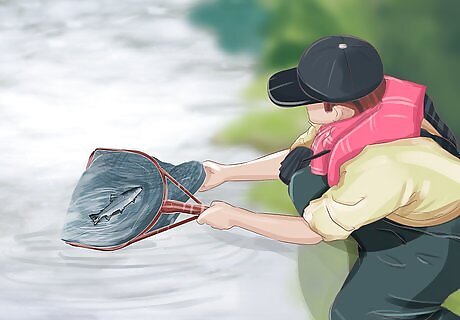
Net your fish once it's tired and in shallow water. After you've hooked your fish, it will begin to fight. It may try to swim upstream or downstream, or it may just jerk the line around trying to get free. The key is to let the fish tire itself out (while moving your rod accordingly), then reel it in. Do not lift your rod up. This could put too much pressure on the rod, causing it to break. Try to keep the fish in the water as much as possible, especially if you plan on releasing it. If you're working with a larger fish, it may be easier to "beach" the fish by leading it onto a bank where the water is shallowest. Move the net into position and gently pull the line to guide the fish head-first over the net's rim. Once the fish's body is past the rim of the net, flick the rim up (to ensure the fish doesn't jump out quickly) while simultaneously lifting the net out of the water. This should prevent escape and send the fish to the bottom of your net. Carefully unhook your fly from the fish's mouth. Remember that it will most likely be thrashing and flailing, so be careful not to cut yourself or hurt the fish.
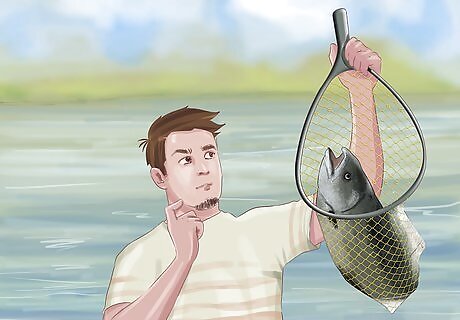
Decide whether to keep the fish or release it. Once you've netted your fish, you'll need to decide whether your fish is big enough to keep. If it's too small, you'll need to release it. Before you do anything, though, you should know the restrictions and requirements in the region where you're fishing. Different regions have differing requirements on the minimum size of a fish. Those requirements may change within a single state if you're fishing in a wilderness area. Some bodies of water (especially those in wilderness areas) may be catch-and-release only. In this case, you must unhook the fish and set it loose in the water. Always check the laws and guidelines in any region you intend to fish. You can find these requirements by searching online, or by asking a park ranger (or the equivalent).
Learning the Basics of Fly Fishing
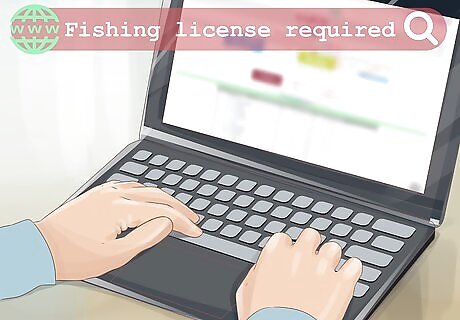
Find out the fishing license requirements in your region. Before you set out for any kind of fishing trip, you'll need a valid license issued by your state. Every state's requirements are different, and some wilderness areas have either more lax restrictions or even greater restrictions/prohibitions on fishing. Getting caught without a license or fishing in a body of water that doesn't allow fishing can land you in trouble with the law, so it's best to comply with your state's requirements and know the rules wherever you intend to fish. Search online to see what your state requires. You can also find helpful courses on e-learning sites like Udemy. You can also find information online on where and how to acquire a fishing license. Some locations may allow you to acquire a fishing license online, while others require you to visit a retail or licensing facility in person. If you need a fishing license quickly, search "fishing license" and the name of the state. In many places, you can use a website or an app to get your fishing license immediately—you just save the license to your phone.
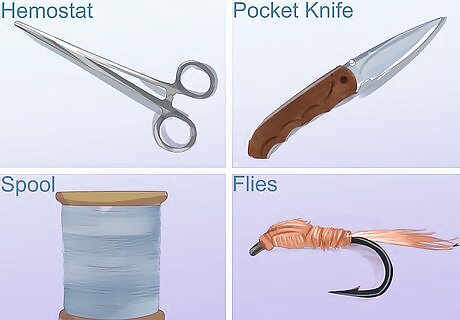
Borrow or purchase quality fishing gear. You'll need some specialized equipment in order to fly fish. If you're working within a budget or aren't sure yet that you'll want to stick with fly fishing, it's best to borrow gear or purchase low-cost equipment. The basics you will need at any price point include: a fly rod (for most freshwater streams, lakes, and ponds, a six to eight-foot rod is sufficient) a spool flies pliers a hemostat (special clamps/forceps used to remove hooks from a trout's mouth) a sharp pocket knife a rod and reel case a fly box to transport your gear a landing net a hat to block out the sun (anything with a brim will suffice) sunglasses with polarized lenses (so you can see through the glare in the water) waders wading boots (for better grip on the slippery riverbed) non-slip feet attachments (like sole spikes) a fly fishing vest with pockets for your tools and flies

Choose effective flies. There are many different types of flies, each one designed to mimic a different aquatic invertebrate. You can purchase pre-made flies at most fishing supply stores, or try making your own. Some of the most common types of flies are designed to look like the following aquatic invertebrates/insects: mayfly hatch Caddisfly hatch stonefly hatch terrestrial hatch (designed to look like and imitate a terrestrial insect) midges scuds leeches dragonfly/damselfly
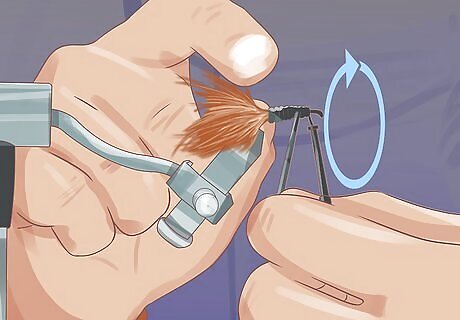
Learn to tie your own dry fly. If you've been fly fishing for a while or simply like working with your hands, you may prefer to make your own fly. Be aware, however, that it can be very time-consuming. You'll need various types of feathers and fur, good eyesight (or a lighted magnifying glass to see better), and skilled hands. Pass the line just before the eye of the hook and wrap it around the shank of the hook to the midpoint. Place your fly materials on the shank of the hook and pinch them in place. Wrap the line around the fly materials until they're firmly in place, then wrap back over the spot you just wrapped. This will help secure the hackles (or whatever materials you're using) in place. If you add any additional materials, make sure they're approximately even/level with the materials already wrapped to your hook. You can split hackles or other materials by separating them a tiny bit (just a half-inch or so at the tips) and wrapping some of the line between them. Apply some wax to the line just before the hook/fly. Pinch and twist a tiny amount of dubbing fur to the wax. Keep twisting and wrapping it in one direction up and down the waxed portion of line until the fur is tightly around that section of the line. Wrap the waxed and fur-wrapped section of line around the hook shank towards the tail, then turn and wrap back over the shank. Tie off the line, cut off any excess thread, and use a drop of liquid cement to secure the whole fly in place.

Tie fly knots more effectively. Whether you're tying your own homemade fly or tying on a store-bought fly, it's important to know how to attach a fly to your line so that it will stay on. Don't tighten any knots until your fly is in position, and make sure you know how to properly secure a fly on your line before you cast into a river. Always wet your knot with saliva or river water before tightening it. This allows you to slide the knot around on the line and get it into place. Keep your knots tight once they're in position. Use a continuous and steady pull on the line, and check that your fly is secure before casting. Trim any excess line off the end past the knot. Try to cut as close to the knot as possible without actually hitting the knot itself.
Finding the Right Time and Place to Fish

Choose a fishing location where fish are likely to gather. Fishing is partly a game of chance, but where you choose to fish can make a big difference in the outcome of your expedition. It's best to choose a quiet, secluded place far from other people (including other fishers). You'll also have to read the water to find the best places to cast, as fish tend to gravitate towards certain underwater environments. Look for boulders and submerged trees/debris. Fish tend to use these underwater areas for shelter/protection, as well as for feeding. Scan the water for any areas just downstream of rocks and trees. Fish commonly position themselves just past these refuge areas knowing that smaller fish and aquatic invertebrates will travel downstream. In the early morning hours you might be able to find fish in unusually shallow water as they search for food. Stand on the bank and scan the shallows for signs of fish. Try casting in undercut banks. If the water has worn out a channel under the bank of the river and created a hollowed-out space, it's a good bet that fish congregate there. Look for pools where the stream/river widens to a gut. The head of the pool (where the pool first widens) is usually a good fishing spot, as well as the slower current just downstream of the head. Avoid casting in the downstream end of a pool (called the tailout). That area tends to be more shallow and near rapids/riffles downstream, so most fish tend to avoid these areas.

Fish at the right time of day. Almost as important as where you fish is when you fish. Fish tend to feed in the morning around sunrise, and again in the evening around sunset. However, if you're new to fishing, it may be easiest to learn how to fish in the midday sun. If you're just starting to learn how to fly fish, you may not know how to spot a fish on the bed or a river. You'll be able to see a fish's shadows most clearly during midday due to the position of the sun and the reduction of glare on the water. If you're just starting out, it may be best to practice spotting fish and casting during the midday sun. You can always stick around until fish become more active, or come back at a later time.
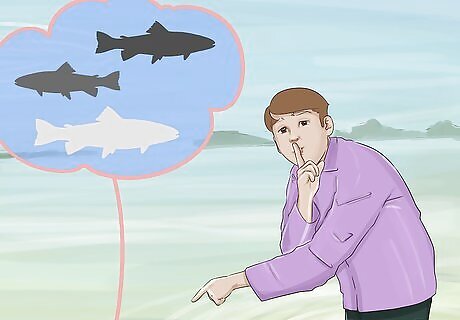
Be quiet and cautious as you approach/enter the stream. Fish are incredibly sensitive to their environment. Any kind of noise can disturb fish, though other factors may also tip them off to your whereabouts. Fish can detect disturbances in the water. Some may even be able to detect disturbances along the shore. Never stomp your feet or make a lot of noise on the banks. Stay in the shade so you don't cast a shadow, or try crouching/squatting as you approach the water. If you intend to wade into the water, move very, very slowly. Walking in too rapidly will create ripples and send the sound through the water column.
















Comments
0 comment